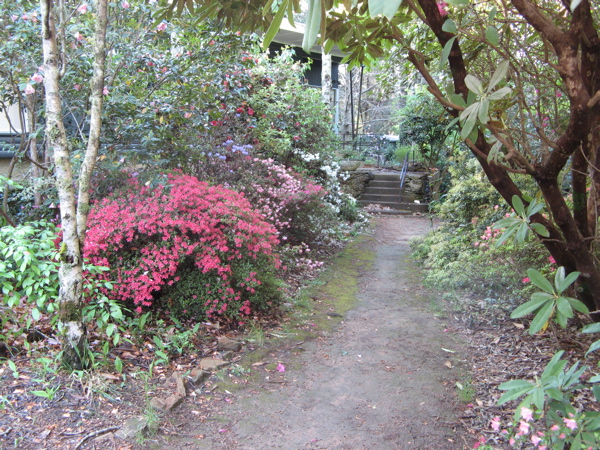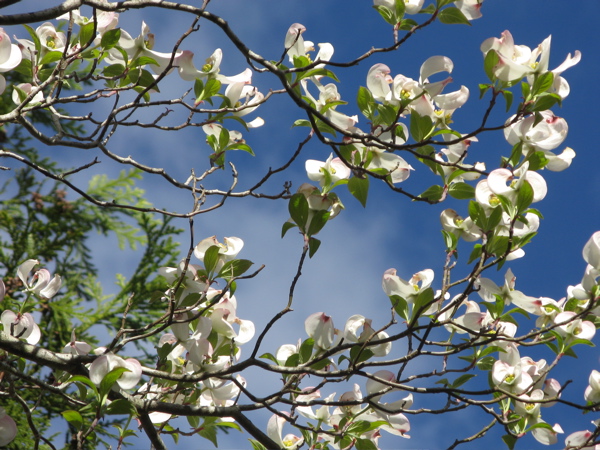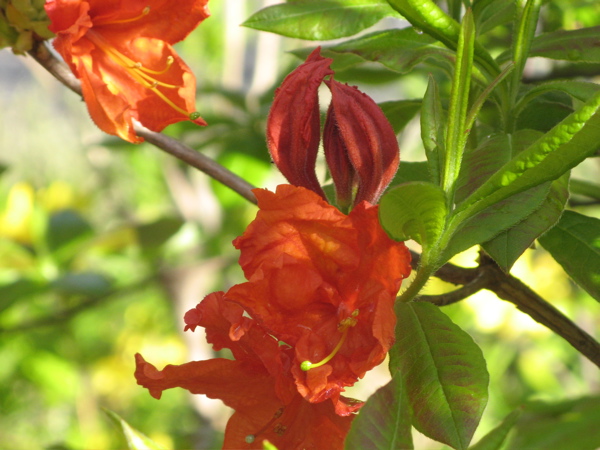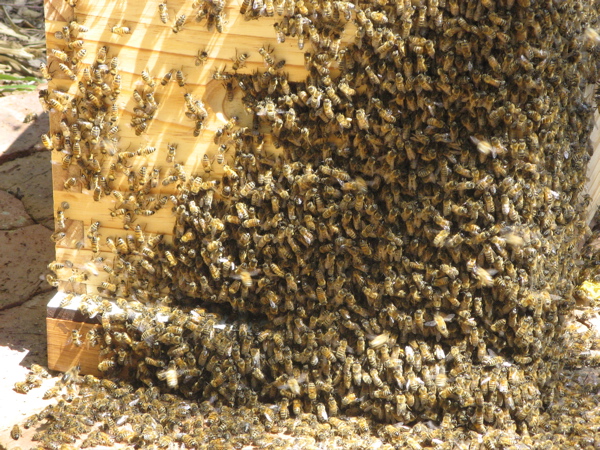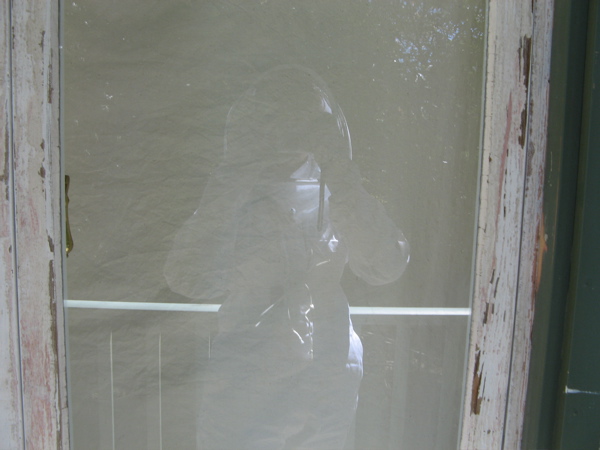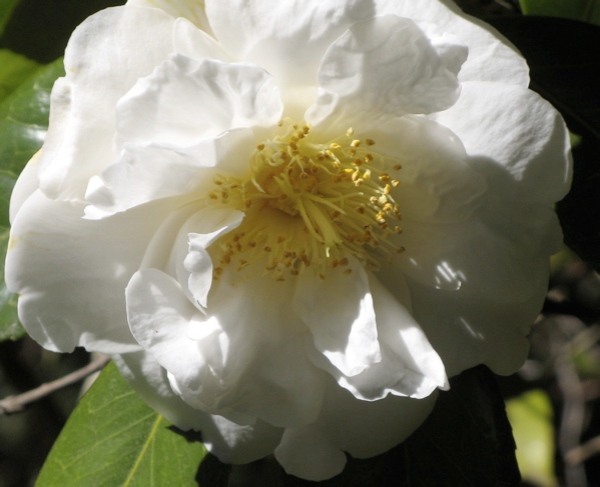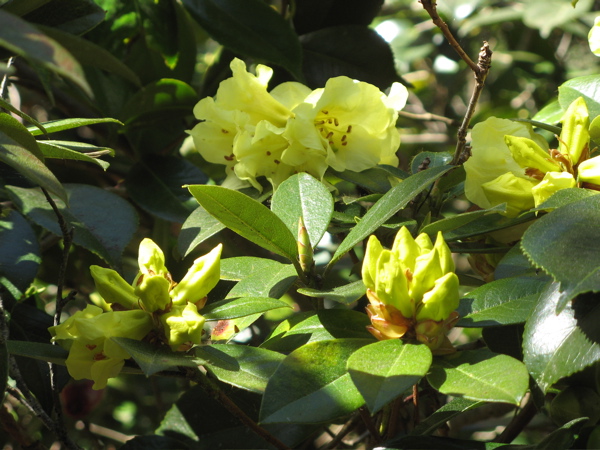The freeze
And so, winter begins to set in. With the wind chill yesterday, the apparent (feels like) temperature was about -10C. There was frost and ice all over the open sections of our yard this morning. The lettuces/greens which were under remay and plastic where icy too. Never having been confronted by this situation before, I almost panicked but then I remembered; water before the sun hits them. This proved a little difficult as the outside tap/pipe had frozen and so, I was ferrying water in my watering can from the laundry. Not a drama but there is nothing like carrying water to make you appreciate the ease that a pipe, tap and hose affords.
Will the lettuces, celery and less hardy greens turn to mush.? Well,we’ll see. Nothing like moving to a new place (albeit, just up the street and round the corner from the old place) to make you learn new things.
Measuring one’s power

No, this is not a logging coop but a section of our yard.
Well, it’s almost 2 months since we settled (closed) on our old place and moved. It’s been interesting getting used to being in the same area but in a different house. Not long after we had moved in, we had 10 extremely large pine trees cut down. They impeded all our NE sun and stopped anything growing on at least half the property. I am no fan of these introduced trees, which are majestic but completely dominate any area they are in. So we made the decision to cut them down (with approval from relevant official bodies) and in doing so, to chip, mill and use all the trees on site.
All of these ‘facts’ and intentions are fine in theory….yes, the trees are a weed; yes, they take up all our light; yes, although I can’t stand pine it will be used for building, furniture making, yes, more suitable trees will be planted to replace them and so on……but when you see trees of 50- 100 years lying on the ground…..well, I burst into tears. It was destruction and those logs could not be put back together.
I was struck by how ‘our’ idea had made this happen. How there were guys, chainsaws, a chipper and a crane and we had initiated the process. How although it is a change for the better and neighbours on the whole were happy to have sun in their yards as much as we were…..it was so intense.
For me, it is a lesson about one’s will and desire. It illustrates to me that what you think, what you think you know and the actual knowing are all very different. And when making a decision even after weighing it all – sometimes we still don’t have any real understanding of how to measure our power.
Considering bees
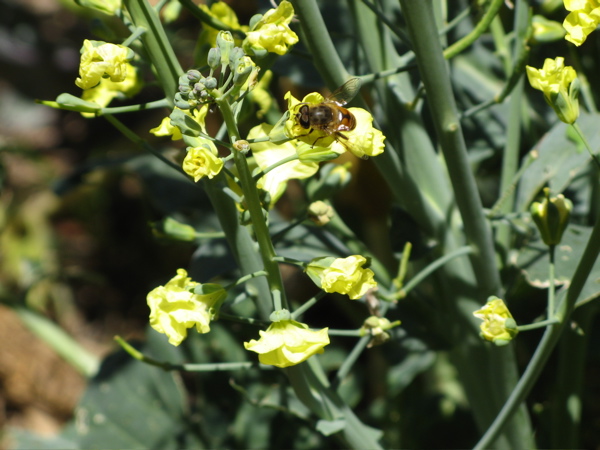
I was going to pull up these brassicas to make way for late summer/autumn plantings until I noticed a familiar smell and sound. Bees – over 20 of them working the flowers. Well, my timetable can wait for the bees, I think. They could be my bees which are housed at my sister’s place about 500 metres away or my friend, Lis’, also a similar distance away or they could be those of another local beekeepers – who knows! Bees travel up to 5kms from their hive, so they could be anyone’s. I should have been painting the house but I kept coming out to watch them. Determination, elegance and zest in their foraging. Is it possible that I’m falling in love with bees?
I did notice when I checked on my bees last week, that the foraging bees were returning with an orange/dark yellow pollen. The colour reminded me of calendula or even dandelion but it could be from the brassicas. It’s interesting to think of the garden with bees in mind. Things that are a weed are often a foraging source for bees particularly in urban or semi-urban settings. Well, even in rural settings – Salvation Jane ( Echium plantagineum) it is to beekeepers – forage for the bees, but to farmers it’s Paterson’s Curse – a weed. The honey is quite runny and sweet. Yum!
Mrs Rae’s Garden redux
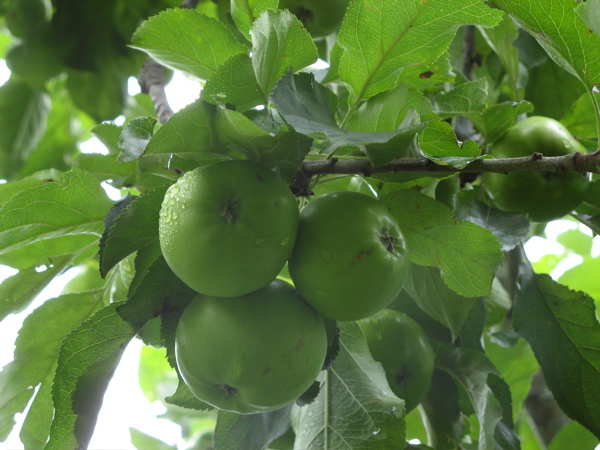
Just so that you don’t think Mrs Rae had a fondness for outlandishly coloured shrubs , there are also a number of very fine trees including an oak, a magnificent towering copper beech, some dogwoods and by the grace of good sense, a tall eucalyptus/ gum. Perhaps the greatest thrill for me has been the discovery of two apple trees. They need some care and “renovation’ so that the fruit can be picked more easily – one tree is the sole territory of noisy rosellas. However, on this kind of pruning/tree rejuvenation, I need to get some advice because I don’t want to kill the gift. Those apples are so cute in their clusters!!
The vegetable garden we started at the new house is really kicking along and we have been eating greens/brassicas, lettuces, beets, radishes, chilli and herbs from the garden for a couple of months. Tomatoes, potatoes, corn, eggplant, beans are flowering and starting to set fruit. I feel very fortunate. And since we have sold our old house, I feel enormous relief. We have to be out of the old place by early February….so we are in the process of moving and painting the new house etc. which leaves little time for gardening. I haphazardly keep shoving stuff in the ground and it keeps growing and growing.
I feel almost giddy, when I think of the garden. Oh, the eternal hope and plans of the gardener….not a bad way to start 2009.
Good fortune and best wishes to you all for the coming year.
Mrs Dorothy Rae’s Garden
Mr and Mrs Rae built our new (to us) house in the mid fifties – I’m guessing originally as a holiday house as the house is compact and modest. They did, however, engage an architect to design it, so I’m also guessing they had some money. I think the house is very cool since I am a big fan of modernism (my secret is revealed) and have always wanted to live in a mid- 20th Century house. And while I love the house (though it has definitely seen better days), the lure of the place was the flat half acre of land. With this land came a very neglected garden, that once was spectacular according to neighbours – Mrs Rae had planned, planted and tended it. The people we bought the place from, evidently were overwhelmed by it or not interested or both. Most of the silver birches have been so badly pruned that it has hastened their demise. I know that they are short lived trees but why would you want to make them look so bad? I’ll spare you the pictorial evidence.
Now, while I would not plant a garden such as this, I do admire the sheer courage of using such dramatic and showy colours in the azaleas and rhodos – both of which come in evergreen and deciduous varieties. There are also ponds, (now dry) stream beds, a small Monet style bridge (was painted in the Giverny green) and even remnants of climbing roses. Not so much in the fruit and vegetable department but this will change!
As things have flowered with the onset of spring, we keep walking around saying things like, “Oh wow, that’s a…..” or “What sort of tree is that?” Reference books have come in handy.
Can anyone help with identifying this tree?
One set of neighbours is worried that, with a focus on food growing, we are going to clear fell the block. Their block was once part of ours, until Mr Rae died and Mrs Rae sub-divided and built a low maintenance brick house on the back quarter acre. She subdivided so as to not ruin the garden aspect of both places. I like Mrs Rae – I wish she still lived in her other little house. We had to ensure the neigbours that we were not vandals or insensitive to our surroundings. Moreover, the local planning authority would be unlikely to allow such dramatic alterations to the streetscape. However, what I wanted to ask them – are vegetables and fruit trees not as beautiful as a camellia or tulip or maple? To me they are, and I think that this is where Mrs Rae and I would have disagreed. Oh and on the use of colour.
Re-housing the bees
A couple of days ago I moved my bees from a 10 frame box into an 8 frame (brood) box and added a super. More room will hopefully avert a swarm. I got stung twice and apart from the initial shock, I did not have an adverse reaction. No swelling, in fact, I swell up much more from mosquito bites.
I was grateful that the bees had overwintered well and that there was no brood disease, beetles or moths in the hive. One thing that I probably have to admit, is that those full depth boxes and frames will be heavy when they are full of honey, so I’m thinking that I might go for the “admit it you’re a girl” half depth boxes. Either that or build up some serious muscle power. I did taste some of the honey from the burr comb that the bees formed in the lid – eucalyptus.
Needless to say they were very confused with the new housing. I think I did okay. I couldn’t see the queen so I hope that she survived. My husband turned up after I’d finished the moving them and as I was just watching them trying to re-organise and also trying learn something of their behaviour. He laughed when he saw me in the suit and thought I looked like someone from a space-exploration program. Yeah, if only NASA was as cool as bees!
Springtime and bees.
In concentrating on our own housing, I almost forgot that with the spring, I’d need to expand the bee quarters. I’ve decided not to go with the accepted industry norm – ie is to soak the boxes in a wood preservative and paint the outside with a exterior gloss paints…instead I (we’ve) been coating the boxes with a combination of raw linseed oil thinned out with some gum turpentine. I know this means much more work but I think that it is also less toxic all round. Not sure how it will affect the longevity of the boxes but there is only one way to find out.
Later this week, I’ll open the hive for the first time since the beginning of winter and I will move the frames into the new boxes. Then in a couple of weeks,I’ll re-queen the hive – it was after all an autumn swarm and the queen in the hive is old. It does sound sinister, I know. Also I need to prepare more boxes and frames in the event that we have good nectar flow – so fingers crossed because really, it is RANK amateur hour here. I’ll try to take pictures to record it all.
The other day as I watched the bees coming and going, landing heavy with yellow pollen I couldn’t get over how amazing they are. Such activity and work. Not sure I’ll be marvelling so much after the first sting!
On silence, slipping/slumping and oh….spring!
If there are any readers left…….my silence is due to really not knowing what to say. I had/have plenty to say but really what is this blogging about? What is this blog about? I still don’t know the answer to those questions but here I am. I think my non-blogging was the result of a winter funk… overcome by the cold and the clouds. My sister, Ms B, tells me that my love of a blue sunny sky means I could never live in London. Fortunately, I don’t wish to. The garden, too, is slow in winter…slower here due to the trees.
I had embraked on a carbon accounting challenge but that soon gave way to accounting of the dollar kind as we made an offer on a new house. This was somewhat unexpected (at this point) but the lure of half an acre of flat-ish sunny land in our town (walking distance to the train, closer to my sister’s place etc.) and a run down modernist house (oh that 50’s flat roof!!!!) all at an exceedingly good price was too much to resist and…..well, as the vendor wanted a quick settlement…it was less than 5 weeks from the time the offer was made to closing. Quick, indeed! It doesn’t quite feel real yet.
The garden was once loved by somebody….lots of camellias, rhodos, azaleas, prunus, maples and cypress but it has been neglected. There are some towering Radiata Pines (weed alert) that we have permission to cut down which will give us much more light….solar access, in planning speak! The timber will be milled for garden beds, a chook house, shelving etc, chipped for mulch and the rest used to bulk out hardwood for the wood heating. They will all be replaced with more appropriate trees- probably fruit and nut trees and some acacias that will fix nitrogen into the soil. Our early plans include chooks, an orchard, lots of vegetable beds, herbs, and a greenhouse. We will keep the camellias etc. because they are probably the original plantings from the 1950’s and the rhodos, as they emerge, look to be some of the showiest, blousiest numbers I’ve seen – a lime (when the sun hits) yellow one is slowly working it’s way into my heart. It is so gaudy.
As exciting as all this is, the reality is that we have to sell our existing home and we know the market is bad but a fair price and a speedy sale is all we hope for. So between organising this house to be ready for sale, starting to plant over at the new place and getting some more work to help pay for it all, I’m just glad it’s (almost) spring and the blue skies, longer days and warmer temperatures mean there is always more daylight to squeeze in some gardening and enjoy the sun.
R4A – 90% reduction: The reckoning (action pt 2)

This is all common sense stuff but here’s the rest –
Petrol – My husband car pools to work with 3 other people. It is a 65km round trip, most week days. We walk to almost all local (in our town) stuff and if I do drive to work (1 or 2 days a week which is about 15kms away) I do our grocery shopping on the way. We would drive to Sydney ( 100kms away) about once a month and usually do errands along the way. I prefer to catch the train to Sydney but it’s not always practical. Along the way, when I was studying, I switched to correspondence/distance education to cut down on both fuel use and time spent travelling.
The only thing to add is that out car is small 4-cylinder hatchback that uses between 4-5 litres per 100kms (same as a Prius though not as comfortable) on the open road. The car is ten years old. We use the highest octane petrol available because it is more efficient, gives you more kms for your money and prolongs the life of your car. This is all better for the atmosphere too. I should add that my husband does the maintenance services for the vehicle himself. He changes the oil every 5,000kms not 10, 000 kms because more frequent oil changes also prolong the life of your car engine and promote better fuel efficiency. We take the oil for recycling to our mechanic. Since we are travelling much less now than when we worked (and commuted) in Sydney, the need to change the oil etc. has also been reduced.
Gas – Heating is our major area of reduction problem as our efforts still do not make the deep cuts necessary. To minimise gas heating use, we have insulated our wooden floor with concertina foil batts (this has reduced temperature loss by 20%) and I am in the process of making calico ( part of my stash) window quilts to put up over the blinds at night to minimise heat loss. We have alot of glass for a small house; 80 sqm including the front deck/verandah and according to our postman live in one of the two coldest streets in our town.
With regard to the central heating, it is used for about 2-3 hours per day and turned on/off manually and only the rooms in use have their radiators turned on. We don’t heat the house at night and really have no need to – it’s not that cold. Blankets and hot water bottles are very useful.
For cold feet, when you feel particularly chilled to the bone, a ginger foot bath will warm you up. Place either a few drops of oil or some grated ginger into a small tub filled with warm/hot water. Soak away. Take care, if the water is too hot, the combination of the warming ginger and hot water will be unbearable.
Food – Accept seasonality but also preserve foods when they are plentiful, so that they get you through the lean period. For example, between August and October, is a lean time for local fruits; apples/pears have ended and summer fruits haven’t started…..so to avoid buying fruit from elsewhere, we will be preserving more fruit this year. Bottling and drying are my only options as I don’t have much freezer space.
We eat a diet based primarily on vegetables, grains, fruits, eggs/dairy with small amounts of red meat and chicken that is local and pasture raised. We grow some food here (herbs, potatoes, garlic and root vegetables do well)- summer being much better than winter. My sister’s garden is nearby – I’ve got some sweat equity there and my mother’s Sydney garden provide a lot of seasonal, perishable vegetables like greens, beans etc. are covered. The productivity of these gardens is increasing. My mother’s garden also provides citrus, figs and papaya. We are very, very fortunate that her garden is already highly productive and that she is generous!
Other sources for local food includes our food co-op (for bulk items and spices too) and local markets. I will buy locally grown produce over organic that has travelled, milk being the only exception. We cut things like maple syrup from our diet because local honey is just as good (better?)- different but just as good. Like the TV, I don’t miss it.
Finding local sources for food, has at times been frustrating especially on the dairy front. Discovering the growers, the networks and so on, intially takes time but has been a great thing to do and it’s been surprising how much food is in your local area. The other thing you discover is that there used to more food production in most areas but land speculation and development has killed it off.
R4A – 90% reduction: The reckoning (action pt 1)
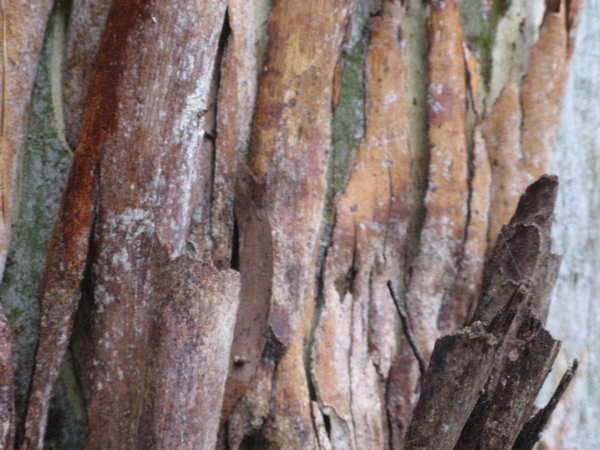
These are the details of what we did in our attempts to achieve the reduction targets. It is the first part of a what is a long post. It seems like a strange thing to tabulate but with the use/price/availability/cost of energy an ever escalating issue, it may amount to more than a fringe experiment or some middle-class, bleeding heart hand wringing.
Electricity – If an item is not in use it is switched off. The exception to this is the fridge and the cordless phone answering machine. I was turning the phone off too and using an ordinary phone but there were complaints from interstate relatives not being able to leave messages and so on. Everything else is switched off – heating controller and gas hot water units when I remember, modem, the electric gas igniter on the kitchen stove…all of it. All lights that we use are CFL’s.
We stopped watching the TV (have given it to one of my sisters) and also sold the dryer which we hardly used anyway.
So what can you run on 2.2kWhs?
An energy efficient fridge which is about 2 years old. Also to improve its power efficiency, it sits about 15 – 20cm away from the wall to allow for better air circulation. I bought a fridge thermometer at a garage sale which sits in the fridge and has enabled me to turn up the thermostat but still maintain the food at a safe handling temperature. I did also did this to the freezer. Most people have their fridge thermostats set at unnecessarily low levels which does little to prolong food shelf life but uses more energy.
4 loads of a small (5kg) capacity front loading washing machine which is about 10 years old and quite energy efficient but not as water efficient as more recent models.
The vacuum cleaner once a week. We use a broom at other times and we take our shoes off at the front door to minimise dirt. This has been very necessary with all the rain we’ve had – sections of our yard that were hard, you now sink into.
Answering machine phone thing, stereo – amplifier and cd player whenever we feel like listening to music, modem, wireless/airport and laptops….I would use the computer for about 2 hours a day. When I was studying this could be up to 6 hours or more but that is not the case now. My husband uses his laptop irregularly but can have spurts of increased use which are work related. All the computer equipment is switched off when not in use. We were doing this anyway, as we have power blackouts in storms and the like.
In the kitchen, we use a toaster daily and about once or twice a week I will use an electric mixer to knead the sourdough until I can handle it and to also to make butter. We would use the food processor and juicer infrequently. We use the dishwasher infrequently as it uses a lot of power ( compared to our other use) although it is water efficient. I would guess that we’ve used it about once every 3 weeks over the last year mainly if we’ve had guests and needed to clear space in the kitchen.
Garbage – To reduce garbage and recycling, I have tried to stop all mailed catalogues and advertisments. We have a no junk mail sticker on our letter box and this stops almost all unsolicited catalogues. However, most paper that does make it into the house, is re-used if it can be, or feed to the worms or composted. All vegetable scraps are also feed to the worms or composted. We plan to add chickens this year, which will give us eggs and manure for the garden.
We buy what we can in bulk or take our own containers/cloth bags to the food co-op. We buy very few food stuffs that are processed elsewhere. This means that I have started making mustards, vinegars, butter,some cheese, more syrups/jams than I used to. I already baked bread ( cakes and biscuits) and we have always cooked from scratch (as the Americans like to say). There are health and financial benefits to this as well and a certain freedom from the supermarket.
I wash any plastic bags that make it into the house (except the ones that had meat in them) and re-use them. We have used rechargeable batteries for years and repair items when needed including shoes, bags and clothes.
Also, I use a keeper and cloth pads when I’m menstruating. TMI, maybe but it’s not gross (that’s for the benefit of my sisters should they be reading!)
Water – We have rainwater tanks for the garden. Since it has rained almost constantly since November 2007, we haven’t really had to water the garden much.
Showers are short and we have a low flow shower head fitted. We had already put a brick in our lowish flush toilet cistern and adopted the “If it’s yellow, let it mellow. If it’s brown, flush it down.” mantra.
While we wait for our water to heat up (for a shower), we collect it in a bucket and use it for washing laundry, cleaning, to flush the toilet or before it started to rain I used to water the garden.
I’m still working on ways to cut the water used in the laundry. This is ongoing. I have been re-using the last rinse water to wash the next load. This has reduced the water use in the laundry by 30%. Interfering with the wash cycle of a front loader is not an easy task. A combination of soaking and agitation in the tub and a rinse spin in the machine is more water and power efficient, produces better results but does take more time.
The remaining categories will be detailed in the next post.
